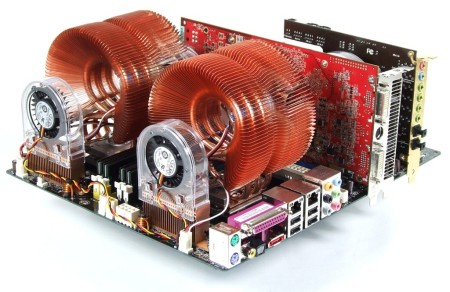Intel Skulltrail 3: 8 vs 4 Core Performance
A Brief History Of Extreme Systems
When the chipmaker introduced its first Extreme Edition processor, Intel was forced to fall back on the workstation and server line of products since its desktop parts lacked the performance. When AMD unveiled its Athlon 64 FX-51, Intel was forced to sell a Xeon processor, which contained an additional 2 MB of L3 cache, as a desktop CPU under the name "Pentium Extreme Edition 3.20 GHz". Initially, these CPUs used the Prestonia core but later transitioned to the newer Gallatin design. At the time, switching to a different motherboard or even an entirely different platform in order to use such an Extreme Edition CPU was not necessary, since Intel packaged the CPU as a desktop part.
The Intel Pentium Extreme 3.20 GHz system
This was possible since the server processors used the same front-side bus protocol as the desktop parts. Only since the desktop and server/workstation technologies have drifted apart has the buyer been forced to buy a special motherboard for an Extreme Edition system.
The AMD 4x4 system
AMD was the first to bring dual-socket systems to the desktop with its 4x4 system. Intel, in turn, was the first to market with a quad-core processor, making AMD fall far behind in the desktop processor performance race. To compensate for this setback, AMD decided to put two dual-core CPUs on a dual-socket motherboard. For this approach, AMD used Opterons from the server segment, which ran a mere 200 MHz faster than any of its siblings at the time and were called "Athlon 64 FX70 to 74." The drawback was that AMD was forced to develop a completely new and very expensive motherboard for the CPU design. To make things worse, there was only one manufacturer that made the motherboard. Today, this system has been all but forgotten, and AMD no longer ships the 4x4 processors.
With the introduction of its Skulltrail platform today, Intel is following in AMD's footsteps. Both the D5400XS Skulltrail motherboard and the new Core 2 Extreme QX9775 processor were originally designed for the workstation/server segment.
The Intel Skulltrail test system
Get Tom's Hardware's best news and in-depth reviews, straight to your inbox.
The system is not exactly a revolutionary step for the users - more like a comparatively cheap server CPU and a specially designed and frightfully expensive motherboard. Intel is expecting its desktop buyers to spend a good deal of money on this combination so that Intel won't have to develop anything new in this arena. We've already seen once before how this story can unfold with AMD's 4x4 system, and the same fate may also await Intel's Skulltrail. As the saying goes, "Those who do not learn from history..."
Current page: A Brief History Of Extreme Systems
Prev Page If you want to build a completely new system around the Skulltrail platform, you should be prepared to invest at least $5,500. Components for the Skulltrail system will be bundled with other parts or sold separately. They should be available in retail cha Next Page Test Setup-
I am a 3D artist so this MoBo will be in my next workstation anyway, but for extreme gamers this review completely missed the point and by more than a mile! First off, looking through all the benchmarks, the overclocked skull trails are top of the bunch in nearly every test, and sometimes way ahead of the others, and anyone that’s going to buy this MoBo is going to overclock! Secondly, I don’t think anyone is going to care about a little extra fan noise for this kind of power, and most likely extremist gamers and 3D pros will use liquid cooling on the CPU’s and Southbridge anyway. But the biggest point of all that toms hardware completely missed is that this MoBo is future proof! Within the next 2 years, 8 core single chips processors will be a reality from Intel and AMD and game developers are going to take full advantage of this I assure you! So in 2 years time when you people that decided to buy a single socket qx9770 system because of this review, and are looking at the benchmarks of people running 8 core systems on the latest games, you’ll probably be cursing toms hardware for this dumb review and feeling sick to the stomach that its upgrade time again, while the people that don’t believe everything toms hardware says is “the law“, and don’t have their heads firmly squeezed up toms dark and scary place, and that are capable of free thinking, will have a huge smile on their faces that their systems brought 2 years ago can still compete with the big boys and that they wisely spent those few extra $$$, £££ or €. I’m certainly not going to let a few games running ever so slightly slower in the now, putting me off buying a MoBo that will run the next gen of kick ass games 1 or 2 years from now. Dumb review toms Hardware dumb!Reply
-
Intel BIOS release 1140 officially supports FSB overclocking and memory ratio overriding. FB-DIMM 800 sticks are also way cheaper now than 6 months ago and I guess they will score sky high with active cooling and low latencies. what about a new testing of the platform with a couple of X5272 to show how easily they cross 4GHz? As my point of criticism, this article should stress the price of the skulltrail is less than half of a single QX9770/QX9775 processor and building a 1P intel system with nvidia chipset can be way harder than this 2P offering.Reply


